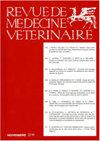哥伦比亚昆迪纳马卡省克里奥尔马精液和阴道前液中钩端螺旋体的分子测定和血清学研究
Q2 Veterinary
引用次数: 0
摘要
本研究的目的是通过血清学(微凝集试验)和分子-钩端螺旋体DNA,通过传统的聚合酶链反应(PCR) -检测血液,射精前液和精液样本中钩端螺旋体的暴露或存在,这些样本来自哥伦比亚克里奥尔马,在康迪纳马卡省44个繁殖中心。在哥伦比亚,没有关于马精液中存在钩端螺旋体的研究,根据为这一物种设计的健康计划,它们没有接种这种疾病的疫苗。共采集动物107只,采用方便抽样法;经血清分析,35例血清反应阳性(32.7%),分别为疑问钩端螺旋体、canicola、pomona、gripo伤寒血清型。两份精液样本经常规PCR检测出钩端螺旋体DNA,占总样本的1.9%。使用暗场技术,在大多数射精前液样本中发现不同的细菌形式,其中一些与钩端螺旋体相容。脱落的细胞、晶体和尿酸盐也被发现。此外,在EMJH培养基中未分离到该细菌,用常规PCR技术从射精前液中未检测到DNA。本文章由计算机程序翻译,如有差异,请以英文原文为准。
Determinación molecular de Leptospira spp. en semen y líquido preseminal y estudio serológico de caballos criollos en el departamento de Cundinamarca (Colombia)
The objective of this study was to serologically (microagglutination test) and molecularly— Leptospira spp. DNA by conventional polymerase chain reaction (PCR)—detect the exposition or presence of Leptospira spp. from blood, pre-ejaculatory fluid, and semen samples in Colombian Creole horses representative of this breed, in 44 breeding centers in the department of Cundinamarca. In Colombia, there are no studies related to the presence of leptospires in equine semen, and according to health plans designed for this species they are not vaccinated against this disease. Samples were collected from a total of 107 animals, selected by convenience sampling; after serum analysis, 35 were seroreactive (32.7%), corresponding to the Leptospira interrogans serogroup, serovars canicola, pomona, and grippotyphosa. Leptospira spp. DNA was detected by conventional PCR in two semen samples that represented 1.9% of the total samples. Using the dark-field technique, different bacterial forms were found in most of the pre-ejaculatory fluid samples, some of them compatible with Leptospira . Desquamated cells, crystals, and urates were also found. In addition, the bacterium was not isolated in the EMJH medium and no DNA was detected by the conventional PCR technique from the preejaculatory fluid.
求助全文
通过发布文献求助,成功后即可免费获取论文全文。
去求助
来源期刊

Revue De Medecine Veterinaire
农林科学-兽医学
CiteScore
1.30
自引率
0.00%
发文量
0
审稿时长
18-36 weeks
期刊介绍:
The Revue de Médecine Vétérinaire publishes four kinds of text:
1) Scientific reviews on subjects related to veterinary and comparative medicine. Suggested length: 10 to 30 typed pages.
2) Original reports on fundamental or applied research. Suggested length: 10 to 15 typed pages.
3) Continuous education articles, that should be easily understandable by non-specialists. Suggested length: 10 to 15 typed pages.
4) Clinical reports. Suggested length: 5 to 15 typed pages.
The publication can be done in French language or English language.
For an article written in English by not english native speakers authors, the manuscript must be subjected by attesting that it was read again by an anglophone scientist or a scientific translator.
The authors must certify that the manuscript was not published or subjected for publication to another review.
The manuscript must be accompanied by a sheet signed by all the joint authors indicating their agreement for the tender of the manuscript.
The publication is free but a financial participation could be required for the photographs color. An estimate will be sent to collect the agreement of the authors.
 求助内容:
求助内容: 应助结果提醒方式:
应助结果提醒方式:


